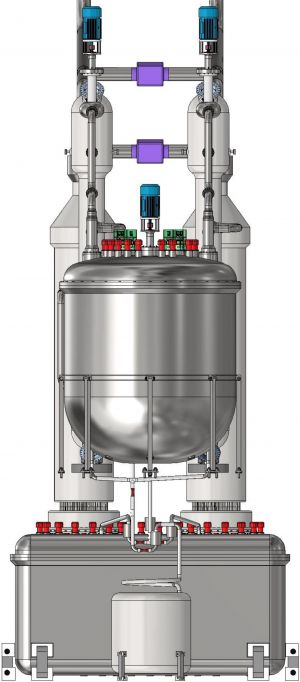The shipbuilding industry has achieved new progress in the field of nuclear-powered commercial vessels, with a groundbreaking liquefied natural gas (LNG) carrier utilizing innovative nuclear technology receiving approval.

On September 9, the Korea Atomic Energy Research Institute (KAERI) and Samsung Heavy Industries (SHI) announced that their jointly developed conceptual design for the world’s first 174,000 cubic meter LNG carrier powered by a small modular molten salt reactor (MSR) will receive Approval in Principle (AiP) from the American Bureau of Shipping (ABS) and the Liberian flag state at the Gastech 2025 exhibition held in Milan, Italy from September 9 to 12.
The approval was formally announced on September 10, marking the world’s first certification of an LNG carrier utilizing a reactor as its power source. This certification represents a critical procedure by classification societies to review novel ship designs or technologies, confirming their compliance with international regulations and safety standards. It serves as the first step toward the actual design and construction of the vessel.
This nuclear-powered LNG carrier utilizes a micro-reactor, jointly conceptualized by KAERI and Samsung Heavy Industries, as its propulsion power source.
Molten salt reactors, as a new generation of reactor technology, utilize molten salt—a mixture of nuclear fuel and coolant—as liquid nuclear fuel. Compared to existing reactors, they offer enhanced safety and energy efficiency, making their application in marine engine technology a subject of significant attention.

According to reports, the molten salt reactor developed for this nuclear-powered LNG carrier achieves a thermal power output of 100 megawatts (MWth). A single reactor installation is sufficient to meet the vessel’s entire lifecycle fuel requirements without the need for refueling.
As the lead research institution, KAERI and Samsung Heavy Industries have jointly advanced the Molten Salt Reactor Core Innovation Technology R&D Project since 2023, supported by the Ministry of Science and ICT and the Ministry of Oceans and Fisheries (MOF). The project aims to complete the conceptual design of a marine molten salt reactor by 2026.
Currently, nuclear propulsion stands as one of the zero-emission technologies under development in the shipping industry, gradually becoming a core R&D focus for shipbuilders. In the container ship market, China’s Jiangnan Shipyard launched the world’s first and largest 24,000 TEU nuclear-powered container ship design in 2023, which has received certification from Det Norske Veritas (DNV).
Jiangnan Shipyard’s 24,000 TEU nuclear-powered container ship employs a fourth-generation molten salt reactor solution. This design ensures high safety through low-pressure, high-temperature reactor operation, inherently preventing core meltdown while incorporating anti-proliferation and intrinsic safety features.
Even in the event of a breach accident, this vessel design enables rapid solidification at ambient temperatures. Following an incident, in addition to standard reactor shutdown procedures, molten salt can be discharged outside the reactor, facilitating rapid shutdown and preventing accident escalation. The propulsion system is positioned in a secure location within the vessel, while the electrical system employs a dual-side redundant design to fully ensure power supply safety. It also incorporates emergency evacuation capabilities from personnel-dense areas.
Earlier this year, HD Korea Shipbuilding & Offshore Engineering (HD KSOE), the shipbuilding holding company under HD Hyundai, unveiled a design for a 15,000 TEU nuclear-powered large container ship, which has been certified by ABS.
HD KSOE stated that the vessel design employs a double-layer structure to shield radiation and ensure safety. Container ships utilizing nuclear propulsion technology do not require the space-consuming exhaust systems and fuel tanks found in conventional vessels, thereby increasing container capacity while enhancing economic efficiency.
Additionally, Norway’s Vard, a subsidiary of Italy’s Fincantieri—one of the world’s largest shipbuilding groups—is collaborating to explore the feasibility of using next-generation nuclear reactors as ship propulsion systems. The company is dedicated to integrating nuclear reactor systems into various vessel types and assessing the technical challenges that must be overcome to achieve the commercialization of nuclear-powered ships in the future.


